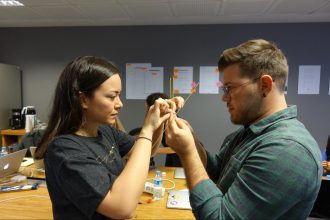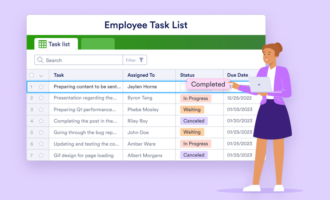8 best practices for team collaboration
- Be open
- Set goals
- Be adaptable and create healthy boundaries
- Be authentic
- Prioritize healthy communication
- Define roles and responsibilities
- Centralize data and documents
- Use software like Jotform Teams
Collaboration isn’t just about getting along with a diverse group of subject matter experts or colleagues. Particularly complex projects and assignments may require multiple contributors, feedback from cross-functional partners throughout the organization, and even cross-cultural engagement (if your work spans multiple borders and countries).
To work together more effectively — either as a leader or a collaborator — consider adopting these eight team collaboration best practices.
1. Be open
If you’re working on a project that requires collaboration, start with an open mind. Consider it an opportunity to learn from an expert in a specific field or topic. Be a sponge and learn whatever you can about your collaborators (while also contributing your own ideas and processes).
Part of being open to collaborative work and new connections is not taking them for granted. You never know when you might work with certain colleagues again or if you’ll need their help in the future.
2. Set goals
Establishing goals up front — perhaps even before you start working on a project — ensures that all collaborators are aligned and working toward the same ultimate purpose. It also allows everyone to buy into key objectives, feel included in the conversation, and stay motivated to get things done together.
The more each team member knows about the project’s goals and objectives, the more effectively they’ll be able to contribute.
3. Be adaptable and create healthy boundaries
Not all collaborations are created equal. Some projects and teams yield better results for both you as an individual and the company as a whole, while others feel exhausting and demanding, making you wonder whether you could accomplish more in less time if you were working on your own.
Creating healthy boundaries in collaborative spaces is one way to ensure you stay productive and on task. Speak up when people aren’t pulling their weight, of course, but don’t force meaningful collaborations or relationships if they’re just not there. It’s impossible to please everyone, and trying to can cause undue, unhealthy stress.
Collaborations are fickle by nature because they’re always changing, but as long as you remain flexible, you’ll be able to work efficiently and successfully with various types of people, personalities, and skill sets.
4. Be authentic
When collaborating with others, you’re most likely going to work with a mix of extroverts and introverts, so it’s important not to force your preferred working style on others. Instead, cultivate a community that allows everyone to work in the way that’s most comfortable to them.
Give them the tools and space necessary to do their best work — whether that’s in a loud, interactive brainstorming workshop where they can work with others or in a quiet office where they can sit, think, and reflect alone.
When we can be our authentic selves at work, we not only come up with the strongest, most astute ideas and project solutions, but we also feel more confident sharing our discoveries with others.
5. Prioritize healthy communication
Without clear, transparent communication, all of these team collaboration best practices will be ineffective. Direct communication helps team members keep each other informed as projects progress and evolve, ensuring everyone can do their best work.
Plus, If an issue arises, healthy communication standards help collaborators feel confident enough to address their concerns in a respectful, professional manner so the project can keep moving forward.
To communicate effectively, you have to be willing to
- Understand, respect, and value different opinions and ideas
- Actively listen — i.e., hear and retain information, observe both verbal and nonverbal cues, provide feedback, etc.
- Help other collaborators solve problems and work through issues
- Meet regularly to avoid misunderstandings and keep projects on track
- Receive and provide constructive criticism
6. Define roles and responsibilities
If collaborators don’t know their specific roles, objectives, and deadlines, the project won’t cross the finish line — at least not in a timely manner.
Before you commit to a due date with a client, it’s important to draft a roadmap of the project. Break it down into steps/tasks — including clear objectives and realistic time frames. Then, decide who the right person is for each task based on workload availability, skill set, and ability to work in a group. Finally, explain specific responsibilities to each collaborator and hold group meetings frequently to discuss how the project is progressing.
Hold group meetings to keep all collaborators accountable, enable everyone to raise concerns regarding potential roadblocks, and allow colleagues to see how important their individual role is to the project as a whole.
7. Centralize data and documents
Whether you’re implementing these team collaboration best practices electronically — which we’ll touch on in the next tip — or manually, one point is clear: Documents and data need to be accessible for all appropriate parties.
Without data centralization, it’s difficult to share data and information conveniently and securely. This hindrance not only increases the chances of project miscommunications, redundancies, unnecessary errors, and overall delays, but it also raises the risk of cybersecurity threats and data breaches.
8. Use software like Jotform Teams
Finally, any list of team collaboration best practices would be incomplete without the mention of software — like shared online workspace Jotform Teams.
Not only does Jotform Teams streamline all the above-mentioned collaboration and communication efforts, but it also allows you to automate workflows, track and manage form submissions, create project folders, and generate reports from the palm of your hand. This powerful, code-free solution even lets you sign and share documents and build apps for specific teams or more complex tasks.
When you implement team collaboration best practices like these, workplace collaboration is far less likely to trigger frustration, stress, and eye rolls. Instead, it can improve employee communication, engagement, morale, and self-confidence across your organization. What’s better — i.e., more productive and profitable — than that?

























Send Comment: